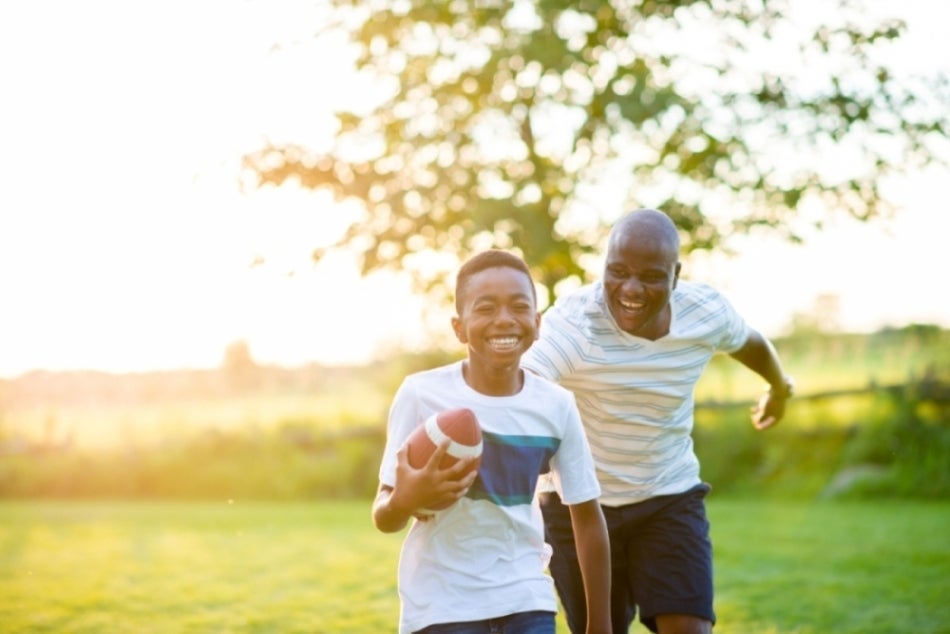Get Outside and Play: How to Stay Safe and Active with Outdoor Sports
May 22, 2025Outdoor sports are a great way to stay active, enjoy fresh air, and connect with others. Whether you're running, biking, playing soccer or throwing a Frisbee in the park, there's something energizing about exercising under the sun. While being active outdoors has many health benefits, it's important to know how to protect your body and prevent injury, especially as the temperatures rise.
David Johnson, DO, a sports medicine expert at Saint Joseph Health System, shares important tips to help athletes of all ages stay healthy, recover safely, and make the most of their time outside.
The most common and preventable outdoor sports injuries
It often starts with a small tweak in your ankle or a dull ache in your shin. Before long, that little issue can grow into something serious. Outdoor sports come with risk, especially if you're jumping in too quickly without preparation.
According to Dr. Johnson, lower body injuries like ankle sprains and stress fractures are among the most common outdoor sports injuries. “We see a lot of runners who increase their training load too fast,” he says. “The bone isn’t ready for it, and it breaks down.”
These stress injuries often appear mid-season, just as athletes are reaching their peak. To avoid this, try to build mileage slowly over the summer rather than jumping into heavy training all at once. Even general strength training or ankle stability exercises can help lower the risk for sprains, especially if you’ve had an injury in the past.
The right way to warm up and stretch
You’ve probably been told to stretch before a workout, but how you warm up can make all the difference. It’s not just about touching your toes.
“Stretching is most useful after your workout,” Dr. Johnson explains. “Before activity, we suggest a dynamic warm-up, something that gets the blood flowing.”
Examples include high knees, butt kicks, and lateral movements like karaokes. These movements increase circulation, loosen up the muscles, and prepare your body for motion. It’s a simple step that can help prevent painful strains and pulled muscles, especially in the legs.
How to safely return to sports after time off
Coming back from an injury or even just a long break can be tricky. You might feel ready to go full speed, but your body needs time to catch up.
If you’ve taken time off, think of your weekly workout schedule like a rollercoaster, not a rocket ship. Dr. Johnson recommends a pattern that includes rest weeks. “Your weekly mileage should look like a stock ticker. It goes up, then drops a bit to give your body a break, then increases again.”
When returning from injury, such as an ankle sprain, it's important to rebuild strength and balance. Exercises that focus on single-leg balance and joint flexibility are key. Saint Jospeh Health System doctors follow a guideline: the injured leg should be at least 90% as strong as the uninjured one before full return to play.
Summer safety for kids playing outdoor sports
Summer sports for kids can be a blast, but they can also be dangerous if parents and coaches don’t take steps to protect young athletes from the heat.
“Younger children are especially vulnerable to heat-related illnesses,” Dr. Johnson says. “Make sure they stay well-hydrated, and don’t wait for them to say they’re thirsty.”
For long or intense practices, children may need electrolyte drinks to replace sodium lost through sweat. It's also critical to ease kids into activity as the weather warms up. A child who hasn’t been exposed to high temperatures is more likely to overheat during a sudden hot weekend tournament.
Watch for signs like fatigue, dizziness, or confusion as these may indicate a serious issue like heat stroke. When in doubt, take a break, move to shade, and hydrate.
How to spot and respond to heat-related illness
It’s easy to ignore the warning signs when you’re focused on the game. But heat illness can escalate quickly and knowing what to look for might save a life.
“Everyone gets hot, tired or sweaty during summer sports,” Dr. Johnson says. “But when someone becomes confused or stops making sense, that’s a red flag.”
Heat stroke can cause slurred speech, disorientation and even unconsciousness. At that point, the body’s core temperature may have exceeded 104°F, putting organs at risk of permanent damage.
Quick action is crucial. In emergencies, cooling the body immediately with cold water immersion or cold towels is the most effective way to reduce body temperature.
Medical conditions that may need sport modifications
Everyone should be encouraged to stay active, but sometimes sports need to be adjusted to keep people safe.
If your child has asthma, a heart condition, or a history of concussions, it’s important to work with a health care provider to determine which sports are safest. Some conditions may require carrying medications like inhalers during games or choosing lower-impact sports with less physical contact.
Dr. Johnson emphasizes the importance of a pre-participation physical with your primary care provider. These visits can help identify underlying health risks before they lead to a problem on the field. “It’s better to catch those issues early,” he says, “so we can guide the family on safe options.”
Mental and physical benefits beyond the field
We often talk about the physical perks of sports, like stronger muscles, better endurance, and a healthier heart. But the mental and emotional benefits are just as powerful.
“Sports can help build lifelong healthy habits,” Dr. Johnson says. “Kids who stay active tend to carry those habits into adulthood.”
Physical activity has also been shown to improve mental health, reduce symptoms of depression, and boost mood. Just 30 minutes of aerobic exercise can sometimes outperform medication in treating mild depression, according to some research.
Whether it's structured team sports or casual backyard games, staying active outdoors is one of the most effective ways to support both your body and mind.


